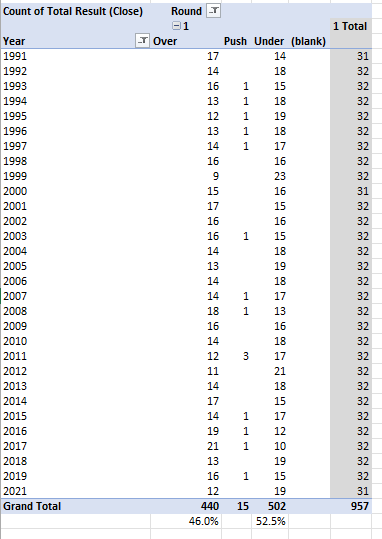Handicapping March Madness 101: 2022 Refresh
Handicapping March Madness can be as simple or difficult as you want it to be. There are many guys who will debate both concepts.
What the most square of betters are doing though is driven by guys who are very risk adverse (maybe driven by personality maybe driven by circumstance of their discretionary income); so really if they were being honest, they'd say they just want to break even and/or make a slight profit.
by playing "All" Conditions. This doesn't work and doesn't not work.... it effectively means you will kinda break even here or there.
 |
| Round 1 Totals Over the Years |
They are going to Vegas and betting on games so they can tell stories to their buddies. They just can't afford to lose money but want to act like big shots betting a lot of money as it makes them feel good. Nothing to be ashamed of UNLESS they think they'll get rich.
If we think about Round 1: Betting all the Overs or Unders, Betting All the Dog MLs, Betting All the Favs, Betting All the Dogs and Points -- it all is going to end up over time between 52%-46%, meaning you will bet a lot, lose a little or win a little and pay some juice.
For many this is totally OK. I just wish these guys wouldn't post on internet like they are A. Going to Get Rich B. Smart Sharp Gamblers
 |
| Round 1 ATS Over the Years |
The path to being very profitable means being willing to take stands based on the actual games, teams and performance trends; instead of arbitrary factors like seeds or conferences. And it also means that you have to be OK with being not profitable.
My path to March Madness selections has evolved over the years;
Beginner: I was like a lot of guys who watched tons of games and was 100% sure I was an expert. I lost money most every year. Years I won, had nothing to do with anything but luck.
Clown: I started listening to guys in the betting lines, understanding what the guys who looked smart than me were betting and working on many simple systems that were effectively based on things like conferences, seeds and what the guys on ESPN said about games (always thinking SU instead of ATS). Pure luck.
Stupid Analytics: I started building simple models and calculations effectively based on stats that were not comparable. Looking at teams FT shooting % and/or how they did on the road v home. Assessment of teams based on common opponents or even trends toward end of season and how they did in conference tournaments. None of this was valid because it failed to account for concepts like strength of schedule or the impacts matchups have on outcomes of teams. The only thing that started to help was I was tracking the results of my models and working to improve them.
Faux Pro: From here I started to build models based on how games were played and based it off of datasets of past performance that were deep, relevant and statistically coorrelated to concepts of the game of basketball shared by experts. I gained access to some professionals and discussed their approaches. I tested models before using them and I was modeling confidence factors so that i could better balance my models confidence with my risk confidence. And predictably I was consistently finding profitable experiences gambling on March Madness, some were bigger than others but the challenge of finding the right answer came with the joy of the money. And I found when I discussed the game with those who were sharp, I was a peer. Acceptance to the club!
Lazy Faux Pro: As my career grew, I had less and less time to dedicate to the huge modeling efforts, so I started to take some of my own models that were consistnetly consistently great and merged them with other projection models that were publically and privatly available. From there I was able to build a Model of Models Approach which drives variable confidence models. And by being fanatical about tracking performance, I have been able to make adjustments to continue to find success.
In that process, I have a few homegrown models that have withstood the test of time, not in their pure form but over time have adjusted to continue to be successful models in the model of models approach. I'm not giving away picks, I'm not asking for money and I'm using these models as a part of my own gambling but never making bets entirely on these models; they are part of what influences my selections.
Many however over the years have been interested in them so I'm posting my refreshed versions of the 3 models that make up the Husted DM over the next couple days.



Comments
Post a Comment